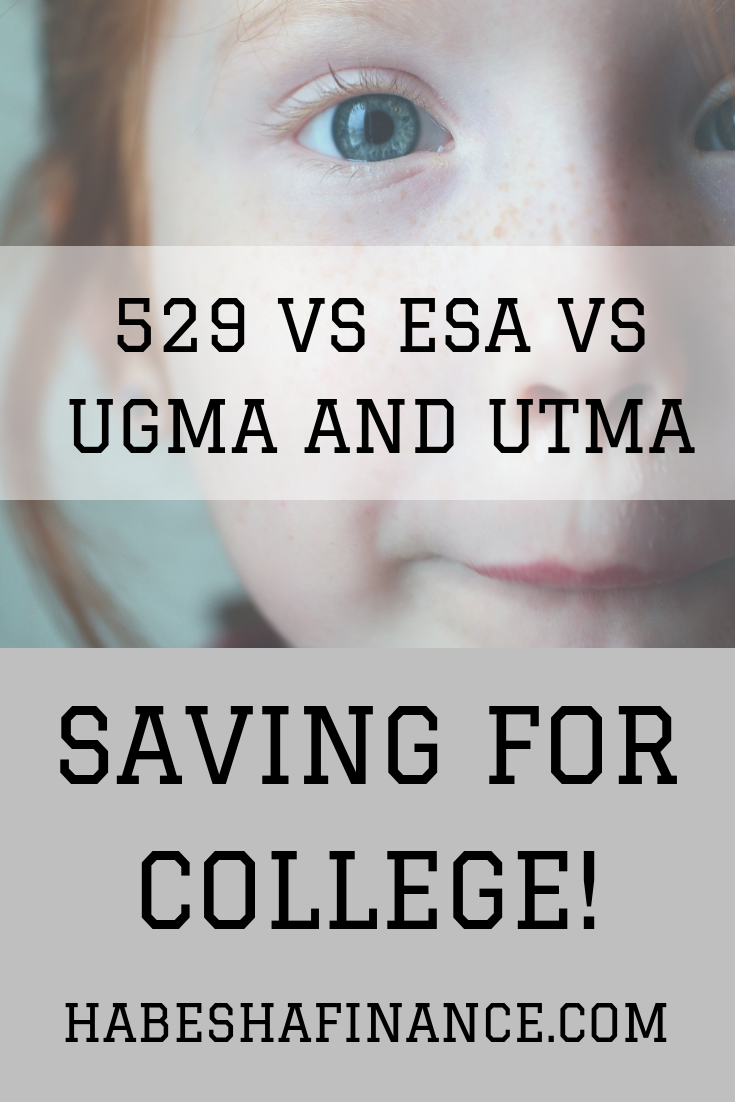Transcript
Are your kids ready for college? I’ve got 4 and I know sooner than later fellow parents are going to realize like we did years ago just how fast the cost of a college education continues to increase. And so in today’s video I’m going to go over the 5 different accounts us parents can contribute to for college and share with you what my wife and I are using for our 4 little ones to save for college.
Coverdell Educational Savings Account
Let’s start with the Coverdell Educational Savings Account (ESA). This is a decent way to save for just about any part of your child’s education. From Kindergarten to after high school, funds in your child’s Coverdell ESA can be used for educational purposes tax-free. You contribute after-tax dollars and the earnings grow tax-free. Sort of like a Roth IRA, except you can only use tax-free growth for educational-related expenses.
The Coverdell ESA does have a $2,000/year maximum contribution limit and certain income restrictions. According to IRS Publication 970, “If your modified adjusted gross income (MAGI) is less than $110,000 ($220,000 if filing a joint return), you may be able to establish a Coverdell ESA to finance the qualified education expenses of a designated beneficiary.” If you don’t meet the income limits you still have other ways to save for your child’s education in other tax-advantaged vehicles which I’ll explain later.
But if you decide to use a Coverdell ESA know that you have up to when the beneficiary reaches age 18 to contribute and NOTE the funds must be used before the child turns 30, unless the beneficiary is a special needs beneficiary. If there are funds leftover by the time your child reaches 30 you have the option to change the designated beneficiary as long as the new beneficiary meets the IRS requirements. Basically any and all family members of the beneficiary can be selected as long as they are under the age of 30. For more information on Coverdell ESAs check out IRS Publication 970.
I will say that investment control in the Coverdell ESA is considered to be optimal as you pretty much have full control over what your contributions can be invested in, unlike 529 plans where the provider typically has the control (there are very few 529 plans where you have the same level of control of investment choices). So, with Coverdell ESAs you have access to more mutual funds and other investment opportunities to potentially maximize your children’s funding for school.
529 Plan
Now onto 529 plans. There is no doubt 529s are a great tool for any parent of any income level to save for college. 529 plans are typically coordinated by a state or an educational institution. Almost every state offers 529 plans. Even if your state doesn’t offer one you can still open a 529 in another state and use the account for any school virtually anywhere. Yep, that means international too! So, if you’re a resident of Florida, you can open a 529 plan in California and your Floridian child can go to college in Georgia and benefit from the California 529. Be sure to confirm the college you want to go to is eligible for Title IV federal student aid and most colleges are, but it’s still something good to check.
There are two types of 529 plans: the prepaid tuition plan and the education savings plan. In this video I am mainly focusing on the education savings plan, because I personally don’t think prepaying college tuition is necessary and there are a few restrictions with prepaid tuition plans that make this option unattractive to me. I am happy to go breakdown the differences in a future video, let me know in the comments section below and remember to subscribe as we journey to 100k subscribers with this awesome community. Only 97,901 of you out there left as of recording this video.
Now, while contributions to a 529 Plan are not tax-deductible on the federal level, the earnings do grow tax-free just like the Coverdell ESA which is a great benefit if you’re able to start one of these plans when your child is very young. Depending on what state you live in you may be eligible for state tax deductions. Contributing to a 529 plan could lower your state tax liability meaning you keep more of your hard-earned money. For example, “Contributions up to $4,000 per year, per beneficiary, are eligible for a Georgia state income tax deduction for those filing a single return; and $8,000 per year, per beneficiary, for those filling a joint return.” So often, people are motivated to open a 529 plan in the state they live in so they can get that tax deduction. When you file taxes and even before it’s a good idea to check with a tax professional to make sure you get the benefit of having a 529 plan.
Another great advantage of the 529 plans is that there are no income limits, unlike a Roth IRA or Coverdell Educational Savings Account which have certain income restrictions. And thanks to a tax law signed by President Trump you can use funds in the 529 plan for qualified “expenses for tuition in connection with enrollment or attendance at an elementary or secondary public, private, or religious school.” This is huge, because you now can save even more for basically all levels of school. We’ll definitely go over the use cases for early education, but for now just know that 529s are awesome, while investment choices can be limited, I still like the 529 plan if you’re able to get a state tax deduction and plan to contribute more than $2,000 per year.
And there’s a new benefit that goes into effect this year with 529 plans. Money that is being contributed in 2024 and the future can be transferred to a Roth IRA which is actually pretty cool! The 529 plan would need to be maintained for 15 years and there is a lifetime maximum transfer of $35,000 so it’s not a perfect case for us to use for future wealth planning for our children, but let’s say you start today contributing to a 529 plan for your child and have an excess of $35,000 to move over to a Roth IRA for the kids by the time he/she is 25. That’s $35,000 your kid would never touch until the age of 59 1/2 and about 34 years of growth with an average annual rate of return of 8% could grow to $570,000. More on 529 plans in a future video, because for my oldest we started her 529 plan 6 years ago so the clock has already started for her, but this is exciting to me and look out for a video that goes into the details of 529s.
UGMAs and UTMAs
The Uniform Gifts to Minors Act (UGMA) and the Uniform Transfers to Minors Act (UTMA) are similar yet somewhat different types of custodial accounts that an adult sets up on behalf a minor. The UTMA is pretty much an extension of the UGMA, which allows the transfer of certain assets to a minor. All assets in these accounts are basically turned over to the beneficiary between the ages of 18 to 21. So, as a parent this kind of scares me to be honest. Imagine you’re saving for your child’s college and there’s always the possibility of those funds being used for something other than college. But I still want to present these accounts to you, because there are some benefits to having these. Still, I would not personally set up an UGMA or UTMA for college purposes.
Unlike 529 plans and ESAs you cannot transfer a designated beneficiary’s UGMA or UTMA account to another person. Ultimately the designated minor owns the assets within these accounts. I know, this might be hard to fathom as parents that you’re kid would have full reign over an account that could have $50-$100k easily. Of course you could have a little Warren Buffet in the making and all would be fine. However, one of the drawbacks on these accounts for education is that these funds can have an impact on the amount of financial aid the beneficiary receives. Financial aid is generally reduced by 20% of the UGMA/UTMA balance compared to the 5.64% of 529s and Coverdell ESAs, because 529s and Coverdells are considered property of the parent.
You’re probably asking what the benefits are right? Well, these accounts are nice for parents with any level of income to provide a decent savings account for their children where you can save and invest. You have the benefit of a wide variety of investment choices. However, be mindful of gift tax on any contributions made in excess of $14,000 ($28,000 joint filers). Also, there are some tax benefits to having an UGMA/UTMA and you don’t have to waorry about paying a penalty if the funds in the account are not used for educational related expenses. The withdrawals just have to benefit the minor, such as college visits, a car for the minor to get to work, summer camp, etc. Again this is where a tax professional can be of good use because there are some tax advantages you could benefit from if you choose to go down the UGMA/UTMA path of saving for college.
Roth IRA
There is another account you can use to pay for college and it’s one that isn’t so well known only because it can be a bit complicated and really isn’t my favorite, but it’s worth looking at. Your Roth IRA. And one of the main reasons I’m including the Roth IRA is because in spite of all the rules and restrictions on making withdrawals without a penalty, using Roth IRA distributions to pay for qualified higher education expenses is considered an exception that you can use and avoid the 10% early withdrawal penalty. However, the earnings portion of the withdrawal—not the contributions—is still considered taxable income.
And Qualified higher education expenses is going to include:
- Tuition and fees
- Books and supplies
- Equipment required for enrollment or attendance
- The cost of special needs services in connection with enrollment or attendance
- Room and board (as long as the student is enrolled at least half time)
One of the big cons about using your Roth IRA for your kids college expenses is that you end up losing a bit of your retirement nest egg and personally it’s something I am not a fan of.
Georgia 529 Plan
Ok, now you’ve read some of the different educational savings vehicles out there and wondering what I would do? What does the Habesha Finance household do for their kids? It all depends if you are able to maximize your tax benefits. I like both the Coverdell ESA and 529 plans, but as a Georgia resident I would have to lean toward the Georgia 529 plan. Remember, I like the 529 plan if and only if you are able to get some state tax deduction. For instance, in the state of Georgia contributions to the Georgia 529 plan are deductible up to $2,000 per beneficiary per year for single filers and $4,000 per year per beneficiary for those filing a joint return. That’s a really great way to keep more of your hard-earned money in your pocket while supporting the financial obligation of your child’s future education.
Now the Georgia 529 plan called “Path2College” offers decent investment options with acceptable fees that you can use to save for college. And putting $100/month away in something as simple as a “Guaranteed Option” investment would save you taxes and get a guaranteed low return on your dollars. Georgia’s 529 Guaranteed Option clearly states, “The minimum effective annual interest rate will be neither less than 1% nor greater than 3% at any time.” That’s better than your typical bank savings account, especially when you consider the state tax deduction!
If you have a toddler or even a newborn there are plenty of decent investment choices available. There are balanced options consisting of half bonds and half stocks (which is what we use), age-based options that become more conservative as your child grows, and aggressive options that offer a majority if not a 100% equity portfolio. Personally, I would go the balanced option seeing as how 18 years is long enough to get a decent return, but just short enough to stay conservative. If this was a 30 or 40 year investment, I would definitely go 100% equity. Then again, I’m not sure I’d want my children staying 30 or 40 years with me before going to college!
One further note I would like to add about the Coverdell ESA and 529 plans is in regard to penalties. Typically non-qualified withdrawals have a 10% penalty along with paying income tax on any earnings. This penalty could go up if folks out there abuse these plans. If your child gets a scholarship you actually get to avoid the penalty, but you will pay income tax on earnings. This makes for a pretty good saving vehicle for just about any scenario that may arise when your child begins life after high school.
If you decide to start one of these college savings accounts be sure to check with a tax, or financial professional. You need to understand the advantages and disadvantages. As always feel free to message me if you have any questions or comments.



![Read more about the article Part 1 of 2 Free Tools to Help You Take Financial Control [A Budget!]](https://habeshafinance.com/wp-content/uploads/2018/08/free-tools-to-help-you-take-financial-control-budget-man-thinking-300x200.png)